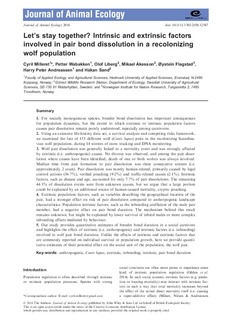| dc.contributor.author | Milleret, Cyril | |
| dc.contributor.author | Wabakken, Petter | |
| dc.contributor.author | Liberg, Olof | |
| dc.contributor.author | Åkesson, Mikael | |
| dc.contributor.author | Flagstad, Øystein | |
| dc.contributor.author | Andreassen, Harry Peter | |
| dc.contributor.author | Sand, Håkan | |
| dc.date.accessioned | 2016-09-28T09:05:52Z | |
| dc.date.available | 2016-09-28T09:05:52Z | |
| dc.date.issued | 2016 | |
| dc.identifier.citation | Milleret, C., Wabakken, P., Liberg, O., Åkesson, M., Flagstad, Ø., Andreassen, H. P., & Sand, H. (2016). Let’s stay together? Intrinsic and extrinsic factors involved in pair bond dissolution in a recolonizing wolf population. Journal of Animal Ecology. doi: 10.1111/1365-2656.12587 | nb_NO |
| dc.identifier.uri | http://hdl.handle.net/11250/2411211 | |
| dc.description.abstract | For socially monogamous species, breeder bond dissolution has important consequences for population dynamics, but the extent to which extrinsic or intrinsic population factors causes pair dissolution remain poorly understood, especially among carnivores.
Using an extensive life-history data set, a survival analysis and competing risks framework, we examined the fate of 153 different wolf (Canis lupus) pairs in the recolonizing Scandinavian wolf population, during 14 winters of snow tracking and DNA monitoring.
Wolf pair dissolution was generally linked to a mortality event and was strongly affected by extrinsic (i.e. anthropogenic) causes. No divorce was observed, and among the pair dissolution where causes have been identified, death of one or both wolves was always involved. Median time from pair formation to pair dissolution was three consecutive winters (i.e. approximately 2 years). Pair dissolution was mostly human-related, primarily caused by legal control actions (36·7%), verified poaching (9·2%) and traffic-related causes (2·1%). Intrinsic factors, such as disease and age, accounted for only 7·7% of pair dissolutions. The remaining 44·3% of dissolution events were from unknown causes, but we argue that a large portion could be explained by an additional source of human-caused mortality, cryptic poaching.
Extrinsic population factors, such as variables describing the geographical location of the pair, had a stronger effect on risk of pair dissolution compared to anthropogenic landscape characteristics. Population intrinsic factors, such as the inbreeding coefficient of the male pair member, had a negative effect on pair bond duration. The mechanism behind this result remains unknown, but might be explained by lower survival of inbred males or more complex inbreeding effects mediated by behaviour.
Our study provides quantitative estimates of breeder bond duration in a social carnivore and highlights the effect of extrinsic (i.e. anthropogenic) and intrinsic factors (i.e. inbreeding) involved in wolf pair bond duration. Unlike the effects of intrinsic and extrinsic factors that are commonly reported on individual survival or population growth, here we provide quantitative estimates of their potential effect on the social unit of the population, the wolf pair. | nb_NO |
| dc.language.iso | eng | nb_NO |
| dc.publisher | Wiley | nb_NO |
| dc.subject | anthropogenic | nb_NO |
| dc.subject | Canis lupus | nb_NO |
| dc.subject | extrinsic | nb_NO |
| dc.subject | inbreeding | nb_NO |
| dc.subject | intrinsic | nb_NO |
| dc.subject | pair bond duration | nb_NO |
| dc.title | Let’s stay together? Intrinsic and extrinsic factors involved in pair bond dissolution in a recolonizing wolf population | nb_NO |
| dc.type | Journal article | nb_NO |
| dc.type | Peer reviewed | nb_NO |
| dc.subject.nsi | VDP::Mathematics and natural science: 400::Zoology and botany: 480 | nb_NO |
| dc.source.journal | Journal of Animal Ecology | nb_NO |
| dc.identifier.doi | 10.1111/1365-2656.12587 | |
